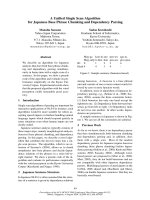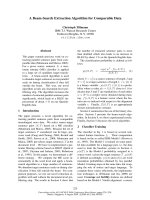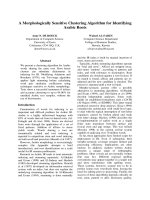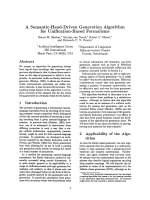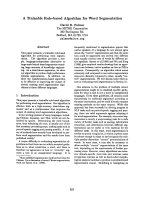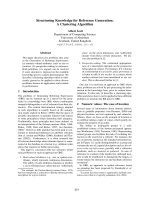a contrast pattern based clustering algorithm for categorical data
Bạn đang xem bản rút gọn của tài liệu. Xem và tải ngay bản đầy đủ của tài liệu tại đây (1.19 MB, 46 trang )
A CONTRAST PATTERN BASED CLUSTERING ALGORITHM FOR CATEGORICAL DATA
A thesis submitted in partial fulfillment
of the requirements for the degree of
Master of Science
By
NEIL KOBERLEIN FORE
B.S., Rhodes College, 2003
2010
Wright State University
WRIGHT STATE UNIVERSITY
SCHOOL OF GRADUATE STUDIES
August 27, 2010
I HEREBY RECOMMEND THAT THE THESIS PREPARED UNDER MY SUPERVISION BY Neil Koberlein
Fore ENTITLED A Contrast Pattern based Clustering Algorithm for Categorical Data BE ACCEPTED
IN PARTIAL FULFILLMENT OF THE REQUIREMENTS FOR THE DEGREE OF Master of Science.
Guozhu Dong, Ph.D.
Thesis Director
Mateen Rizki, Ph.D.
Department Chair
Committee on
Final Examination
Keke Chen, Ph.D.
Krishnaprasad Thirunarayan, Ph.D.
Andrew T. Hsu, Ph.D.
Dean, School of Graduate Studies
iii
ABSTRACT
Fore, Neil Koberlein. M.S., Department of Computer Science and Engineering, Wright State
University, 2010. A Contrast Pattern based Clustering Algorithm for Categorical Data.
The data clustering problem has received much attention in the data mining, machine
learning, and pattern recognition communities over a long period of time. Many previous
approaches to solving this problem require the use of a distance function. However, since
clustering is highly explorative and is usually performed on data which are rather new, it is
debatable whether users can provide good distance functions for the data.
This thesis proposes a Contrast Pattern based Clustering (CPC) algorithm to construct
clusters without a distance function, by focusing on the quality and diversity/richness of contrast
patterns that contrast the clusters in a clustering. Specifically, CPC attempts to maximize the
Contrast Pattern based Clustering Quality (CPCQ) index, which can recognize that expert-
determined classes are the best clusters for many datasets in the UCI Repository. Experiments
using UCI datasets show that CPCQ scores are higher for clusterings produced by CPC than those
by other, well-known clustering algorithms. Furthermore, CPC is able to recover expert
clusterings from these datasets with higher accuracy than those algorithms.
iv
TABLE OF CONTENTS
Page
1. INTRODUCTION AND PROBLEM DEFINITION 1
2. PRELIMINARIES 3
2.1 Clustering, Datasets, Tuples, and Items 3
2.2 Frequent Itemsets 3
2.3 Terms for CPC 4
2.4 Equivalence Classes 4
2.5 F
1
Score 5
2.6 CPCQ 5
3. RATIONALE AND DESIGN OF ALGORITHM 7
3.1 MPD and CPC Concepts 7
3.2 MPD Rationale – Mutual Patterns in CP Groups 8
3.3 Mutual Pattern Quality 9
3.4 Pattern Volume 10
3.5 Example 11
3.6 MPD Definition 12
3.7 The CPC Algorithm 13
v
3.7.1 Step 1: Find Seed Patterns 14
3.7.2 Step2: Add Diversified Contrast Patterns to G
1
15
3.7.3 Step 3: Add Remaining Patterns Based on Tuple Overlap 16
3.7.4 Step 4: Assign Tuples 17
4. EXPERIMENTAL EVALUATION 19
4.1 Datasets and Clustering Algorithms 19
4.2 CPC Parameters 20
4.3 Experiment Settings 21
4.4 SynD Dataset 21
4.5 Mushroom Dataset 22
4.6 SPECT Heart Dataset 22
4.7 Molecular Biology (Splice Junction Gene Sequences) Dataset 24
4.8 Molecular Biology (Promoter Gene Sequences) Dataset 24
4.9 Effect of Pattern Limit on Execution Time and Memory Use 25
4.10 Effect of Pattern Limit on Clustering Quality 27
4.11 Effect of Pattern Volume on Clustering Quality 28
5. RELATED WORKS 30
6. DISCUSSION AND CONCLUSION 32
6.1 Alternative Approaches to Cluster Construction 32
6.2 Tuple Diversity 33
vi
6.3 Item Diversity 33
6.4 Chain Connections through Mutual Patterns 34
6.5 Discussion on MPD Values 34
3.7 Conclusion and Future Work 35
REFERENCES 36
vii
LIST OF FIGURES
Figure
Page
1. Intra-Group Connection through a Mutual Pattern 9
2. Mutual Pattern Quality 10
3. CPC Algorithm Steps 14
4. CPC Step 1 Pseudocode 15
5. CPC Step 2 Pseudocode 16
6. CPC Step 3 Pseudocode 17
7. CPC Step 4 Pseudocode 18
8. Execution Time: Mushroom, minS=0.01 26
9. Memory Use: Mushroom, minS=0.01 26
10. Effect of maxP on F
1
and CPCQ scores: SPECT Heart 27
11. Effect of maxP on F
1
and CPCQ scores: Mushroom 28
viii
LIST OF TABLES
Table
Page
1. SynD and its CPC Clustering 12
2. SynD clusterings and CPCQ Scores 21
3. Mushroom F
1
and CPCQ Scores 22
4. SPECT Heart F
1
and CPCQ Scores 23
5. Splice F
1
and CPCQ Scores 24
6. Promoter F
1
and CPCQ Scores 25
7. Effect of PV on F
1
Score: Mushroom, Splice 29
8. Effect of PV on CPCQ Score: Mushroom 29
ix
ACKNOWLEDGEMENTS
I would like to give my special thanks to Dr. Dong, for his kindness and patience
in helping me to accomplish this work. Without his valuable guidance, this thesis would
not have been possible.
I would also like to thank Dr. Keke Chen and Dr. Krishnaprasad Thirunarayan for
being a part of my thesis committee and giving me helpful comments and suggestions.
Finally, I would like to thank my parents for their support and love throughout
my studies at Wright State.
1
1. INTRODUCTION AND PROBLEM DEFINITION
Clustering is an important unsupervised learning problem with relevance in many
applications, especially explorative data analysis, in which prior domain knowledge may be
scarce. Traditional approaches to clustering often make use of a distance function to define the
similarity between data points and guide the clustering process. Good distance functions are
crucial to clustering quality, but they are domain-specific and can require more knowledge than
is available to users.
This thesis proposes a novel Contrast Pattern based Clustering (CPC) algorithm for
discovering high-quality clusters from categorical data without relying on prior knowledge of the
dataset. Since clustering is highly explorative, such an algorithm may often be preferred over
one requiring a user-provided distance function. Ideally, this algorithm should be scalable and
able to produce clusters that correspond closely to the classes provided by domain experts for
datasets having expert-provided classes. To accomplish this, CPC only relies on the frequent
patterns of the given dataset. Specifically, it is designed to maximize the Contrast Pattern based
Clustering Quality (CPCQ) score. The CPCQ index has been demonstrated to recognize expert
clusterings as superior to those created by well-known algorithms [1].
While the CPCQ index scores whole clusters based on the contrast patterns of those
clusters, CPC constructs clusters bottom-up on the basis of frequent patterns only and hence
does not have access to the whole clusters (and their associated contrast patterns) during the
cluster-construction process. Therefore, the challenge here is to establish a relationship
between individual patterns and use it to guide the clustering process. This is done using a
2
formula termed Mutual Pattern Density (MPD). The key idea of MPD is that disjoint tuple sets
(associated with different patterns) are likely to belong to the same cluster if they share a
relatively large number of patterns (i.e. many patterns that match many tuples in one of the
tuple sets also match many tuples in the other tuple set). MPD allows us to construct clusters
whose contrast patterns have high quality individually and are abundant and diversified.
3
2. PRELIMINARIES
This chapter introduces terms and concepts necessary to understand CPC. We begin
with the fundamentals of datasets and patterns. Then, we introduce terms specific to CPC and
briefly explain equivalence classes. Finally, we summarize the CPCQ scoring index.
2.1 CLUSTERING, DATASETS, TUPLES, AND ITEMS
Clustering is the grouping of data into classes or clusters, so that objects within a cluster
have high similarity in comparison to one another but are very dissimilar to objects in other
clusters. In this thesis, the set of data to be clustered, called the dataset, is assumed to be in
tabular form, with each row representing a data point or object and each column representing
some characteristic of each object. A dataset in this form is also known as a relation. In a
relation, each row (object) is called a tuple, and each column (characteristic) is called an
attribute. When attribute values are categorical, they are often called items. A set of items
(such as from a single tuple) is called an itemset, and a set of tuples is called a tuple set.
2.2 FREQUENT ITEMSETS
In this thesis, the term pattern is a synonym of frequent itemset – an itemset occurring
in multiple tuples of a dataset. When a pattern's items are a subset of a tuple's itemset, we say
that the tuple matches the pattern. When all of a pattern's matching tuples form a subset of a
certain tuple set, we say the tuple set contains the pattern.
The support of a pattern is the frequency with which it occurs in the dataset with
respect to the total number of tuples in the dataset; this can be expressed as a percentage or a
fraction. Similarly, the support count of a pattern is the total number of tuples matching that
4
pattern. Patterns with lower support are usually considered less interesting, so a minimum
support threshold is used to define the support below which patterns are discarded as
uninteresting. Finally, it is possible that, given a pattern P
1
with support supp(P
1
), a super-
itemset (i.e. a superset of items) P
2
of P
1
may exist such that supp(P
2
) = supp(P
1
); this implies
that P
1
and P
2
are patterns matching the same tuple set. A pattern having no such super-
itemset is called a closed pattern.
The process of discovering the patterns present in a dataset is called frequent pattern
mining. Because CPC constructs clusters on the basis of patterns, it must be implemented in
conjunction with a frequent pattern miner. Our implementation of CPC uses an implementation
of the FP-Growth algorithm [2], although other algorithms could be used.
2.3 TERMS FOR CPC
We write mat(P) to denote the matching tuple set of a pattern P. Given tuple sets TS
1
and TS
2
, a mutual pattern is a pattern P whose tuple set mat(P) intersects both TS
1
and TS
2
but is
equal to neither. Throughout this thesis, we often use X to denote a mutual pattern while using
P to denote any pattern. Moreover, we use PS to denote a pattern set, C a cluster, CS a
clustering (cluster set), T a tuple, TS a tuple set, and D the entire dataset. Given a pattern P, |P|
denotes its item length, and P
max
denotes its closed pattern. When mat(P) intersects a tuple set
TS, we say that P overlaps TS.
2.4 EQUIVALENCE CLASSES
Each pattern P is associated with an equivalence class (EC) defined by the set of all
patterns {P
EC
| mat(P
EC
) = mat(P)}. Each EC can be concisely defined by a closed pattern and a
set of minimal generator (MG) patterns. In any EC, no MG pattern is a subset of another
pattern, and each pattern is a superset of at least one MG pattern and a subset of the closed
pattern. For efficiency, CPC does not consider each pattern in an EC. Instead, the term
5
"pattern" refers to an EC, and |P| for a pattern (EC) P refers to the average length of the MG
patterns in the EC.
2.5 F
1
SCORE
A common measure of accuracy is F
1
score, which we will use to compare CPC
clusterings to expert clusterings. The F
1
score for a single cluster is defined as the harmonic
mean of its Precision and Recall. Given that a cluster is a set of assigned tuples, Precision and
Recall for "test" cluster C
T
(produced by CPC or another algorithm) and expert cluster C
E
are
defined as:
,
=
,
=
The F
1
score for C
T
with respect to C
E
is:
1
,
= 2
(
,
) (
,
)
(
,
) + (
,
)
The overall F
1
score, F
1
(CS
T
, CS
E
), for a clustering CS
T
with respect to an expert clustering CS
E
is
the weighted sum of the maximum F
1
scores with respect to each expert cluster C
E
, weighted by
the support of C
E
:
1
,
=
1
,
In this formula, |D| is the number of tuples in the dataset.
2.6 CPCQ
Another measure of clustering quality is the CPCQ index, which we use not only to
evaluate CPC, but also to guide its design. The CPCQ index is a clustering quality index for
categorical data, designed to recognize high-quality clusterings without the need for a distance
function. In CPCQ, a high-quality clustering is one having a high number of diversified contrast
6
patterns for each cluster. A contrast pattern (CP) is a pattern with significantly higher support in
one cluster than in any other, thus serving to characterize its "home" (target) cluster and
differentiate it among other clusters. Two CPs are considered diversified in terms of their items
and tuples; if two CPs share few items/tuples, then item/tuple overlap is low, and item/tuple
diversity is high. To measure the abundance and diversity of CPs in each cluster, the CPCQ
algorithm builds a number of diversified CP groups for each cluster. Ideally, the average
pairwise tuple- and item-overlap among CPs should be low within each CP group, each CP group
should cover its entire cluster, and the average pairwise item overlap among CPs from different
CP groups should be low (although tuple overlap among CP groups of a cluster is inevitably
high). This ensures that each tuple of a cluster matches a number of diversified CPs.
Additionally, CPCQ measures the internal quality of a contrast pattern P by its length ratio
|P
max
|/|P|. This is because a shorter MG pattern acts as a greater discriminator while a longer
closed pattern indicates greater coherence within mat(P). In this thesis, we frequently make use
of the notions of diversity, CP groups, and length ratio.
7
3. RATIONALE AND DESIGN OF ALGORITHM
In this chapter, we describe the concepts, rationale, and algorithm for CPC. We begin by
introducing MPD and explaining its rationale as well as its use in clustering a simple synthetic
dataset. Then, we formally define MPD. Finally, we describe the CPC algorithm in detail.
3.1 MPD AND CPC CONCEPTS
As mentioned in the introduction, MPD establishes a relationship between individual
patterns. The MPD value for patterns P
1
and P
2
, denoted MPD(P
1
,P
2
), is the sum of weights
assigned to the mutual patterns of mat(P
1
) and mat(P
2
). MPD(P
1
,P
2
) is high if a large portion of
the patterns overlapping (mat(P
1
) mat(P
2
)) are high-quality mutual patterns of mat(P
1
) and
mat(P
2
). CPC uses MPD both to find a set of weakly-related patterns as seed patterns to initially
define the clusters, and later to select and add patterns to their most relevant clusters.
Since the goal of CPC is to construct clusters that maximize the CPCQ score, each cluster
must have many diversified CPs. This is partly accomplished by constructing clusters on the
basis of patterns. That is, clusters are represented as pattern sets rather than tuple sets until
the final step. Then, the pattern sets are used to assign tuples to the clusters. This approach
ensures that many high-quality CPs exist in each cluster.
To ensure diversity, patterns are selected to create one high-quality CP group G
1
for
each cluster C, denoted G
1
(C), while maximizing the potential for additional high-quality and
diversified CP groups. Diversity in G
1
(C) is guaranteed because only patterns with very small
tuple overlap with each G
1
(C) are candidates in this selection process. To maximize the
potential for additional diversified CP groups, patterns are added based on their MPD values
8
with each G
1
(C), denoted MPD(P,G
1
(C)). A high MPD(P,G
1
(C)) value indicates that mat(P) has
high overlap with many CPs of C. Therefore, P is a strong candidate if it has a high MPD(P,G
1
(C))
value for one cluster a low value for every other cluster. Since mat(G
1
(C)) typically covers the
majority of the cluster, this step ensures that many CPs exist for building additional CP groups.
The algorithm does not actually build these additional groups; experiments show that this
approach can efficiently ensure a high-CPCQ clustering.
3.2 MPD RATIONALE – MUTUAL PATTERNS IN CP GROUPS
One rationale for MPD is based on the need for coherence among diversified CPs inside
a CP group. Because diversity is high among CPs in a high-quality CP group, these CPs are not
directly connected to each other in terms of their tuple sets or itemsets. In fact, if the CPCQ
score is based on a single, high-quality group G
1
per cluster, then reassigning the tuple set of any
pattern P
1
of G
1
to another cluster will not significantly affect the total CPCQ score (barring any
difference in item overlap, a measure of diversity).
This is not the case when the score is based on two or more groups per cluster, as
required by the diversity requirement of the CPCQ index. In any high-quality group G
2
≠ G
1
of a
cluster, each pattern X of G
2
sharing tuples with a pattern P
1
of G
1
often also shares tuples with
other patterns P
2
of G
1
. That is, X is likely to be a mutual pattern of mat(P
1
) and mat(P
2
).
Therefore, reassigning mat(P
1
) to another cluster would remove X from the set of CPs, requiring
G
2
of C to be rebuilt for a different CPCQ score. For this reason, we say that X connects P
1
and P
2
to C. This is illustrated in Figure 1. In the figure, each rectangle represents the items of a
pattern, and each tuple spans the width of the dataset.
9
Figure 1. Intra-group connection through a mutual pattern
3.3 MUTUAL PATTERN QUALITY
Since CPs are not known until the clusters are determined, all mutual patterns must be
considered when evaluating the strength of the connection between patterns (i.e. candidate
CPs) P
1
and P
2
. A mutual pattern X is strong in connecting P
1
and P
2
if 1) it is a CP of the same
cluster, and 2) assigning P
1
or P
2
to a different cluster would remove X from the set of CPs.
Similarly, X is weak in connecting P
1
and P
2
if it is unlikely to be a CP, or if assigning P
1
or P
2
to a
different cluster would not prevent X from being a CP.
To reflect the above in MPD(P
1
,P
2
), a weight is assigned to each mutual pattern X
indicating the certainty of (1) and (2). For (1), the weight of X is higher if its support count
outside (mat(P
1
) mat(P
2
)) is low. For (2), the weight of X is higher if its overlaps with mat(P
1
)
and mat(P
2
) are both high. For example, if X shares many tuples with P
1
but few with P
2
, then
assigning P
1
and P
2
to different clusters would not necessarily prevent X from being of a CP.
Examples of high-quality and low-quality mutual patterns are illustrated in Figure 2.
10
Figure 2. Mutual pattern quality
These concepts also apply to the mutual patterns connecting a pattern P and cluster C
represented by the pattern set G
1
(C), since mat(G
1
(C)) can be defined as the unioned matching
tuple sets of all patterns in G
1
(C). Finally, because X is a candidate CP, its weight also increases
with its item length ratio |X
max
|/|X|. Shorter MG CPs act as stronger discriminators while longer
closed patterns indicate greater coherence in mat(X).
3.4 PATTERN VOLUME
A high MPD(P
1
,P
2
) or MPD(P,G
1
(C)) value requires not only that the qualities of
individual mutual patterns are high, but also that these mutual patterns comprise a large
portion of all patterns overlapping (mat(P
1
) mat(P
2
)) or (mat(P) mat(G
1
(C))). A large portion
is preferred over just a high count so that the most exclusive connections are favored. For
example, if many patterns overlap mat(P), then many mutual patterns may exist between P and
each cluster since each overlapping pattern is potentially a mutual pattern, but that does not
imply that P is a strong candidate for each cluster when adding patterns to G
1
. Therefore, MPD
values are normalized by the pattern volume (PV) of each argument's matching tuple set.
11
The PV of a tuple set TS is the weighted sum of its overlapping patterns. Each pattern is
weighted by its item length ratio squared and its support count with respect to TS:
=
2
()
PV will be used to normalize MPD values in the following way: Given patterns P
1
, P
2
, and P
3
, if
PV(mat(P
2
)) = y * PV(mat(P
1
)), then mutual patterns of mat(P
1
) and mat(P
3
) are given y times as
much weight as those of mat(P
2
) and mat(P
3
) when evaluating MPD. Experiments show that F
1
and CPCQ scores are significantly higher when MPD values are normalized by PV. It is worth
noting here that length ratio is squared in all CPC formulas; this adds weight to the value and
results in a slight overall improvement in clustering quality.
3.5 EXAMPLE
The simple dataset SynD below is clustered using CPC. Ten equivalence classes exist in
SynD (with minimum support count = 2) and can be identified by their MG patterns: EC
1
: {a1};
EC
2
: {a2}; EC
3
: {a3}; EC
4
: {a4}; EC
5
: {a5}; EC
6
: {a6}; EC
7
: {b1}; EC
8
: {b2}; EC
9
: {b3}; EC
10
: {b4}.
We can intuitively see that the given clustering is the best for two clusters C1 and C2 since it is
the only one in which C1 and C2 have no items in common. Notice that mutual patterns only
exist for the matching tuple sets of patterns contained in the same cluster (e.g. {a2} overlaps
mat({b1}) and mat({b2}), {a5} overlaps mat({b3}) and mat({b4}), etc.), and no mutual patterns
exist between C1 and C2.
When constructing C1 and C2, the seed patterns could be any pair of patterns from
separate clusters in this case because the MPD value would be zero for each pair. Suppose {a1}
and {a6} are chosen as seeds. Then, {a2} would be added to G
1
(C1) (currently defined by {{a1}})
because |mat({a1}) mat({a2})| = 0 (i.e. diversity is high) and mat({a1})'s only overlapping
pattern, {b1}, is a mutual pattern of mat({a1}) and mat({a2}), making MPD({a1},{a2}) the highest
12
MPD value for C1. Similarly, {a5} would be added to G
1
(C2), and so on. When completed, G
1
(C1)
= {{a1}, {a2}, {a3}} and G
1
(C2) = {{a4}, {a5}, {a6}}, and tuples are assigned to clusters as shown in
the table. Also notice that {{b1}, {b2}} and {{b3}, {b4}} are additional diversified CP groups for C1
and C2, respectively. So, each pattern is a member of a CP group, each CP group covers all
tuples in its cluster, and the CPCQ score is maximized.
Table 1. SynD and its CPC clustering
tuple ID
A1
A2
cluster ID
1
a1
b1
C1
2
a1
b1
C1
3
a2
b1
C1
4
a2
b2
C1
5
a3
b2
C1
6
a3
b2
C1
7
a4
b3
C2
8
a4
b3
C2
9
a5
b3
C2
10
a5
b4
C2
11
a6
b4
C2
12
a6
b4
C2
3.6 MPD DEFINITION
Formally, MPD is defined in terms of patterns P
1
and P
2
as follows:
1
,
2
=
1
2
2
1
2
In this formula, X is a mutual pattern of mat(P
1
) and mat(P
2
), and |mat(P
1
) mat(P
2
)| is
assumed to be very small. This definition reflects the properties described in the previous
sections. A mutual pattern is given more weight if it has a high item length ratio, high overlap
with mat(P
1
), high overlap with mat(P
2
), and low overlap with (D – (mat(P
1
) mat(P
2
))). In
addition, MPD values are higher if a larger portion of the patterns overlapping (mat(P
1
)
mat(P
2
)) are mutual patterns.
13
MPD for a pattern P and pattern set PS must also be defined since patterns are to be
scored with clusters, represented by pattern sets. MPD(P,PS) can be defined similarly to
MPD(P
1
,P
2
):
,
=
2
In this formula, mat(PS) =
P
{mat(P) | P PS}. Evaluating MPD is computationally expensive in
both cases, so we precompute |mat(P
1
) mat(P
2
)| for each pair of patterns (P
1
,P
2
), as well as
PV(mat(P)) for each pattern P. To make use of these precomputed values in MPD(P,PS),
MPD(P,PS) is approximated heuristically as the weighted average of all values in the set {MPD(P,
P
i
) | P
i
PS}, weighted by PV(mat(P
i
)):
,
,
Given K clusters C
1
,…,C
K
, each represented by a pattern set G
1
(C
i
), this approximation allows
MPD(P, G
1
(C
i
)) to be stored for each (P,C
i
) pair and updated as necessary by computing only
MPD(P,P
added
), where P
added
is the pattern last added to G
1
(C
i
). These changes significantly
reduce execution time (typically by two orders of magnitude in our experiments) without
significantly changing results. However, precomputing |mat(P
1
) mat(P
2
)| significantly
increases memory use. Excessive memory use is avoided by ignoring patterns with the lowest
item length ratios.
3.7 THE CPC ALGORITHM
CPC uses MPD to construct clusters bottom-up on the basis of patterns. After frequent
patterns have been mined from the dataset to be clustered, a set of seed patterns is chosen
based on low MPD values to initially define the set CS of K clusters, {C
1
,…,C
K
}. At this point, each
C
i
CS is represented by the singleton set of patterns, G
1
(C
i
). Then, patterns with very small
14
overlap with each current cluster are added to G
1
(C
i
) based on high MPD values with their target
clusters. To refine the clusters, G
1
(C
i
) is fixed, and each remaining pattern is added to the
pattern set PS(C
i
) G
1
(C
i
), based on its tuple overlap with G
1
(C
i
). Tuples are finally assigned to
clusters based on the clusters associated with their matching patterns. In list form, these steps
are:
1. Find K seed patterns, one for each cluster.
2. Add diversified patterns based on MPD values, forming a CP group G
1
for each cluster.
3. Add remaining patterns to the pattern sets of the clusters based on tuple overlap.
4. Assign tuples to clusters based on their matching patterns.
These steps are illustrated in Figure 3 and described in detail in the next sections.
Figure 3. CPC algorithm steps
3.7.1 STEP 1: FIND SEED PATTERNS
A set SS of seed patterns is defined as K patterns for which the maximum MPD value
between any two is low. Exhaustively searching each possible set is very expensive, so a
heuristic is used: a fixed number of seed sets meeting an overlap constraint is selected at
random and scored by the maximum MPD value between any two patterns of a set. A set SS
best
15
with the lowest score is chosen. Then, the algorithm refines SS
best
by iterating through each
pattern S
i
in SS
best
, and replacing S
i
with a pattern P having the best improvement over S
i
; this is
repeated until no seed pattern is replaced after a cycle. Pseudocode for this step is shown in
Figure 4. This method can be replaced by other seed set initialization methods.
Input: K: the number of clusters; PS: the set of mined patterns; M: the number of randomly
generated seed sets
Output: SS: the set of seed patterns
// Select initial seed set
Randomly generate M unique K-size seed sets, each set SS
cand
= {S
1
… S
K
}, satisfying:
|mat(S
i
)| ≥ median support count in PS for 1 ≤ i ≤ K;
|mat(S
i
) mat(S
j
)| ≤ threshold * min(|mat(S
i
)|,|mat(S
j
)|) for 1 ≤ i < j ≤ K;
Let SS
min
be a seed set among these sets minimizing max{MPD(S
i
,S
j
) | 1 ≤ i < j ≤ K};
// Refine seeds
REPEAT // Find best replacement for each seed pattern
FOR i = 1 to K, DO
Let PS
cand
be the set of all patterns in PS satisfying:
|mat(P)| ≥ median support count in PS;
|mat(P) mat(S
j
)| ≤ threshold * min(|mat(P)|,|mat(S
j
)|)
for 1 ≤ j ≤ K and j ≠ i;
Find a pattern P in PS
cand
minimizing max{MPD(P,S
j
) | 1 ≤ j ≤ K j ≠ i};
IF max{MPD(P,Sj) | 1 ≤ j ≤ K j ≠ i} < max{MPD(S
i
,S
j
) | 1 ≤ j ≤ K j ≠ i} THEN
Replace S
i
with P;
END IF;
END FOR;
UNTIL no improving replacement seed is found for any S
i
after a complete FOR loop;
Mark each seed as "used" in PS;
RETURN SS
min
.
Figure 4. CPC step 1 pseudocode
In our implementation, at most M = 2 * 10
K+3
sets are generated, and the value for threshold is
0.05/(K-1). Also, only patterns with support counts of at least the median support count are
considered; this forces each seed to cover a more significant portion of its cluster without
excessively reducing the number of candidate seeds.
3.7.2 STEP 2: ADD DIVERSIFIED CONTRAST PATTERNS TO G
1
This step creates a CP group for each cluster C
i
by adding diversified patterns to each
cluster. A pattern is a candidate only if its overlap with each cluster's matching tuple set is
16
under a threshold. The candidate P associated with the highest MPD(P,G
1
(C
i
)) value is then
added to G
1
(C
i
), and the process repeats until no candidates are found after an iteration.
Although a low MPD(P,G
1
(C
j
)) value for each C
j
≠ C
i
is also desired, a high MPD(P,G
1
(C
i
)) value
implies this since a large portion of patterns overlapping mat(P) must be high-quality mutual
patterns of mat(P) and mat(G
1
(C
i
)). The pseudocode for this step is shown in Figure 5.
Input: K; PS; SS
Output: G
1
of the K clusters
FOR i = 1 to K, let G
1
(C
i
) = {S
i
}; // Initially define CS from SS
WHILE (not all patterns in PS are used), DO // Patterns are marked "used" in the previous step
Let PS
cand
be the set of all unused patterns in PS satisfying:
|mat(P) C
i
| ≤ threshold * min(|mat(P)|,|C
i
|) for 1 ≤ i ≤ K;
Let P
best
= argmax
P
MPD(P,G
1
(C
i
)) for 1 ≤ i ≤ K; // P ranges PS
cand
Let C
max
= argmax
C
MPD(P
best
,G
1
(C));
IF (MPD(P
best
, C
max
) > 0) THEN
G
1
(C
max
) = G
1
(C
max
) {P
best
};
Mark P
best
as "used" in PS;
ELSE BREAK;
END WHILE;
RETURN G
1
(C
1
),…,G
1
(C
K
).
Figure 5. CPC step 2 pseudocode
In our experiments, the value for threshold is 0.05. Note that only one pattern is added per
iteration, and the gaining cluster depends only on the highest MPD value among the candidates;
two or more patterns can be added consecutively to a single cluster.
3.7.3 STEP 3: ADD REMAINING PATTERNS BASED ON TUPLE OVERLAP
Although the patterns of G
1
of each cluster can cover the entire dataset, undecided and
disputed tuples will most likely exist. To assign them to clusters, this step considers all patterns
not yet assigned. This should not be confused with adding more patterns to G
1
(C); in this step,
patterns are added to the pattern set PS(C), which is a superset of G
1
(C). Each of these patterns
is added according to its maximum Normalized Tuple Overlap (NTO) with a cluster C:

